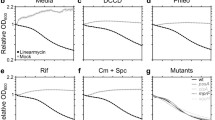Abstract
The combined action of polyene macrolid antibiotic amphotericin B and styryl dye RH 421 in model lipid membranes and in yeast Saccharomyces cerevisiae is studied. Addition of RH 421 to ergosterol-containing lipid bilayers leads to an increase by 8.5 ±3.2 times of the equilibrium number of open amphotericin channels. The agar-diffusion method shows that RH 421 enhances the antimicrobial effect of amphotericin B, leading to an increase by 1.5 times of the zone of growth inhibition of S. cerevisiae strain. Our data suggest that RH 421 is a potential synergist of amphotericin B and can be used in novel drugs with improved pharmacological properties.
Similar content being viewed by others
Abbreviations
- AB:
-
amphotericin B
- DMSO:
-
dimethylsulfoxide
- DPPCh:
-
1,2-diphytanoyl-sn-glycero-3-phosphocholine
References
Andreoli, T.E., The structure and function of amphotericin B-cholesterol pores in lipid bilayer membranes, Ann. N.Y. Acad. Sci., 1974, vol. 235, pp. 448–468.
Bolard, J., How do polyene macrolid antibiotics affect the cellular membrane properties?, Biochim. Biophys. Acta, 1986, vol. 864, pp. 257–304.
de Kruijff, B., Gerritsen, W.J., Oerlemans, A., Demel, R.A., and van Deenen, L.L., Polyene antibiotic-sterol interactions in membranes of Acholeplasma laidlawii cells and lecithin liposomes. I. Specificity of the membrane permeability changes induced by the polyene antibiotics, Biochim. Biophys. Acta., 1974, vol. 339, pp. 30–43.
Ghannoum, M.A. and Rice, L.B., Antifunginal agents: mode of action, mechanisms of resistance, and correlation of these mechanisms with bacterial resistance, Clin. Microb. Rev., 1999, vol. 12, pp. 501–517.
Gray, K.C., Palacios, D.S., Dailey, I, Endo, M.M., Uno, B.E., Wilcock, B.C., and Burke, M.D., Amphotericin primarily kills yeast by simply binding ergosterol, Proc. Natl. Acad. Sci. USA, 2012, vol. 109, pp. 2234–2239.
Hebeka, E.K. and Solotorovsky, M., Development of resistance to polyene antibiotics in Candida albicans, J. Bacteriol., 1965, vol. 89, pp. 1533–1539.
Kasumov, Kh.M., Struktura i membrannaya funktsiya polienovykh makrolidnykh antibiotikov (Structure and Membrane Function of Polyene Macrolide Antibiotics), Moscow: Nauka, 2009.
Lang, T.A. and Sesik, M., Kak opisyvat’ statistiku v meditsine. Annotirovannoe rukovodstvo dlya avtorov, redaktorov i retsenzentov (How to Describe the Statistics in Medicine: An Annotated Guide for Authors, Editors, and Reviewers), Moscow: Prakticheskaya meditsina, 2011.
Marty, A. and Finkelstein, A., Pores formed in lipid bilayer membranes by nystatin, differences in its one-sided and two-sided action, J. Gen. Physiol., 1975, vol. 65, pp. 515–526.
Montall, M., and Muller, P., Formation of bimolecular membranes from lipid monolayers and study of their electrical properties, Proc. Natl. Acad. Sci. USA, 1972, vol. 65, pp. 3561–3566.
Nes, W.R., Sekula, B.C., Nes, W.D., and Adler, J.H., The functional importance of structural features of ergosterol in yeast, J. Biol. Chem., 1978, vol. 253, pp. 6218–6225.
Ostroumova, O.S., Efimova, S.S., and Schagina, L.V., Probing amphotericin B single channel activity by membrane dipole modifiers, PLoS ONE, 2011, vol. 7, p. e30261.
Sherman, F., Fink, G.R., and Hicks, J.B., Laboratory Course Manual for Methods in Yeast Genetics, New York: Cold Spring Harbour, 1986.
Shigemi, A., Matsumoto, K., Ikawa, K., Yaji, K., Shimodozono, Y., Morikawa, N., Takeda, Y., and Yamada, K., Safety analysis of liposomal amphotericin B in adult patients: anaemia, thrombocytopenia, nephrotoxicity, hepatotoxicity and hypokalaemia, Int. J. Antimicrob. Agents, 2011, vol. 38, pp. 417–420.
Spencer, F., Hugerat, Y., Simchen, G., Hurko, O., Connelly, C., and Hieter, P., Yeast kar1 mutants provide an effective method for YAC transfer to new hosts, Genomics, 1994, vol. 22, pp. 118–126.
Thompson, G.R., Caneda, J., and Patterson, T.F., Overview of antifungal agents, Clin. Chest. Med., 2009, vol. 30, pp. 203–215.
Author information
Authors and Affiliations
Corresponding author
Additional information
Original Russian Text © E.V. Mikhailova, S.S. Efimova, O.S. Ostroumova, 2013, published in Tsitologiya, Vol. 55, No. 2, 2013, pp. 136–139.
Rights and permissions
About this article
Cite this article
Mikhailova, E.V., Efimova, S.S. & Ostroumova, O.S. Effects of styryl dye RH 421 on the activity of amphotericin B in cell and model membranes. Cell Tiss. Biol. 7, 289–292 (2013). https://doi.org/10.1134/S1990519X13030097
Received:
Published:
Issue Date:
DOI: https://doi.org/10.1134/S1990519X13030097




